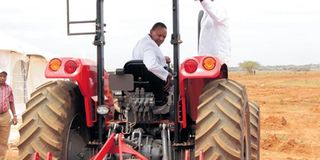Sh400bn Galana irrigation scheme ‘back on course’

President Uhuru Kenyatta during the official ground breaking ceremony for the Galana/Kulalu Model Farm at Galana in Tana River County. The second phase of the Sh400 billion Galana-Kalulu project is set to start even as experts warn that it is not financially and environmentally viable. FILE PHOTO | LABAN WALLOGA |
What you need to know:
- Contract signing ceremony with Israeli firm for a ‘model farm’ to be done on Tuesday, with the first crop expected in February 2015.
- Eventually, private investors are expected to acquire the one million acres under irrigation.
The Sh400 billion Galana Kulalu irrigation scheme which had seemingly steered off course, is back on track, Agriculture Cabinet Secretary Felix Koskei has said.
Away from funding hitches that the one-million acre project had faced recently, a contract signing ceremony with Israeli firm Agri Green to build the “model farm” will be done on Tuesday.
The first crop could be realised around February next year, said the CS. Galana Kulalu irrigation project seeks to reclaim one million acres to irrigation by 2017.
The project hopes to have 500,000 acres of land under maize production, 200,000 acres under sugarcane farming, 150,000 acres on beef and game animals, 50,000 acres under horticulture, 50,000 acres for dairy farming and the remaining 50,000 acres to grow fruits.
SIGN THE CONTRACT
“We will sign the contract with Agri Green on Tuesday. This will pave the way for us to get 2,000 acres of the project before year end,” the minister in an interview at his offices on Friday. He maintained that the project was back on track after initial delays.
A 10,000-acre State-run pilot farm to be set up would require a dam. The minister said Israel had agreed to finance the model farm on Galana River at a cost of $651 million (Sh55.3 billion).
He said the Agriculture ministry was looking for funds to put up the farm and build the dam.
He attributed a three-month delay to “geotechnological investigation”, a tedious process of mapping the areas that have low water levels near the river.
The minister said designs for the project started last November and lasted four months before the project was significantly expanded in April.
TEST CONCEPTS
The plan was to set up a 10,000-acre model farm to test concepts that the government had in mind. If successfully implemented, the project would boost investor confidence.
Eventually, private investors are expected to acquire the one million acres under irrigation.
“In April, we added a detailed design project component — a model dam and 10,000 acres for Phase 1 of the project”.
The first 10,000 acres of the project will use water from the Galana River. “We will construct a dam to support the entire farm. This will take about 14 months, plus putting up related infrastructure,” he added.
The minister spoke after MPs recently questioned the viability of the project, saying President Kenyatta may have been misled to launch the pilot phase in January. Not so, the CS said.
“The President launched consultancy services and commencement of the model farm,” said Mr Koskei.
The consultants are Agri-Green of Israel and two local firms, Amiran and Enviro-plan. They gave us their final report on April 30.
In the fiscal year 2014/15, the National Treasury allocated Sh3.5 billion to the irrigation scheme, which was revived in January. The money will be used to put up at least one million more acres under irrigation in Tana River and Kilifi counties.
SUNK IN CONSULTANCY
But MPs took issue with the fact that, of the Sh1.6 billion spent on the project so far, Sh920 million — equivalent to 57.5 per cent — was sunk in consultancy.
Other expenses are Sh110 million for development of a model farm, Sh490 million for rehabilitation of infrastructure, Sh32 million for a study on soil suitability and Sh50 million on facilitation, including transport and vehicles.
“The Galana ranch is expansive and undeveloped. Roads were impassable and planes couldn’t land. It was for that reason that the ministry, through the National Irrigation Board, concentrated on rehabilitating airstrips and roads, said the CS.
Once completed, the project is expected to reduce human-wildlife conflict by forming a buffer zone between Tsavo East National Park and local communities.




